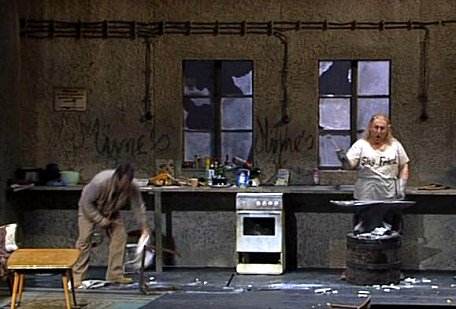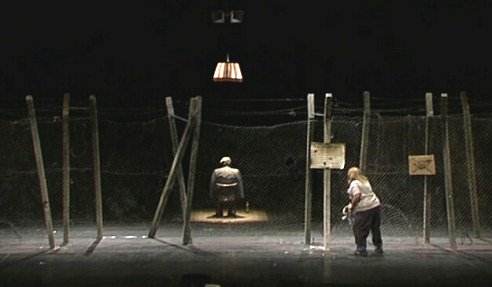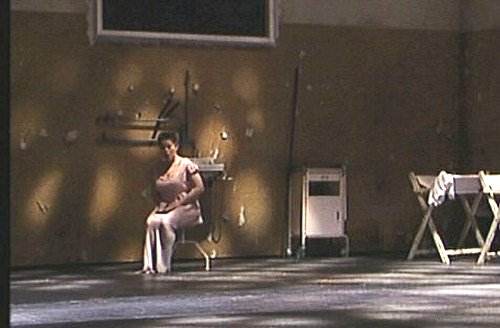
Stuttgart Staatstheater
Staatsoper Stuttgart’s
2002 ‘Ring’ was based on the ‘innovative’
idea of having different directors and
casts for each part of the tetralogy
and is now being released on DVD. I
assume that the Stuttgart Intendant,
Klaus Zehelein thought initially
that combining four different views
of Wagner’s drama would reveal more
aspects of its plot and characters than
any single production might do, so that
the independent interpretations could
coalesce into an original and overarching
Konzept of the work as a whole.
On the strength of this Siegfried
though, the notion seems to have misfired
badly for this is a one dimensional
interpretation which presents the work
as a comic-book with music.
The music is done pretty
well however and the singing is of a
generally high standard. Lothar Zagrosek
may not be an incandescent Wagnerian
but he is never less than satisfactory
and the music moves along nicely with
proper regard for its drama and lyricism.
No great risks are taken with the score
under Zagrosek’s direction but nothing
goes very wrong either. It is middle
of the road, but is enjoyable.
In similar vein, most
of the singers give very competent performances.
John Fredric West as Siegfried manages
the forging song very well even though
he is not the heldentenor to
light the world up exactly. His voice
holds up perfectly adequately even when
partnered by Lisa Gasteen’s powerful
and dramatic Brünnhilde and Heinz
Göhrig’s tuneful Mime. These singers,
together with Attila Jun’s Fafner, Helene
Ranada’s Erda and Gabriela Herrera’s
Woodbird offer very pleasurable listening
to which no one could take exception.
The principals are a strong vocal team,
let down only by Björn Waag’s rather
lightweight Alberich and Wolfgang Schöne’s
vibrato smitten Wanderer.
Music is one thing
but production is another, and Gerhard
R. Koch’s booklet essay gives an instant
flavour of this one. Siegfried is an
‘über-oaf,’ Koch says, given to
‘truly infantile tantrums’ who has the
words ‘Sieg’ and ‘Fried’ written separately
on his tee-shirt ‘which shows that he
comes from: not the forest, not myth,
but a comic.’
Koch goes on to say
that ‘Jossi Wieler’s direction … exercises
an unprecedented power to draw from
Siegfried the glummest of all
comedies, making laughter die in the
throat, and presenting only one negative
figure: the Wanderer, Wotan’. Here the
god is ‘a schizoid: the CEO of Walhall
Inc. who has lost his power base’ and
has become ‘an elegant old rocker in
jeans, leather jacket and shades, impotent
but still enjoying sadistic little games
like the quiz in which Mime’s head is
the prize.’
Now, in case anyone
thinks that I’m an unreconstructed traditionalist
when it comes to opera production, I
should mention here that I liked Robert
Wilson’s Royal Opera Aida (review)
when most other reviewers hated it,
and that I’ve seen an enjoyable Ring
where the Valkyries rode about on mountain
bikes carrying the bandaged body parts
of dead heroes on their handlebars.
So what I’m puzzled about here is not
that this production is post-modern;
rather it is that the producer / directors
think that spelling out everything comic-book
fashion somehow illuminates the subtleties
of Wagner’s text. Less is quite often
no more, unless you happen to
be Roy Lichtenstein.

Heinz Göhrig (Mime)
and Jon Fredric West (Siegfried)
Sets and costumes are certainly glum
though. Act I is set in Mime’s dingy
all- purpose backyard kitchen/dining-room/
workshop which has peeling plaster and
broken windows where Mime beats out
the Nibelung anvil rhythm on the side
of a bowl in which he peels potatoes.
Siegfried enters dressed in a fur hat
and coat over his tee-shirt, jeans and
trainers (Adidas not Nike, I’d suggest)
and threatens Mime with a pair of fur
covered paddles on poles. When CEO Wotan
arrives on the scene, he points a pistol
at Mime while challenging him to the
riddles, and good taste forbids me saying
what Mime does next. Siegfried fires
up the forge with a foot pump, before
smashing some more windows and then
rhythmically wafts extra draught through
the room with its door.

Attila
Jun (Fafner) and Jon Fredric West (Siegfried)
Act II is glummer still.
The woodbird is a ‘little blind boy:
not a being of pristine nature at all
but a tool in a rigged game driven only
by erotic urges.’ (Would that be the
bird or the rigged game, I wonder.)
Fafner sits inside a ‘military exclusion
zone’ on a chair with his back to the
audience and also has the words ‘Sieg’
and ‘Fried’ on his shirt but in mirror
writing so that ‘the killer is already
inscribed deterministically on the victim.’
A witty ‘No Horns Allowed’ sign hangs
on the wire perimeter. There’s very
little ‘Ho, Hi’ here at all: just ‘Ho,
Hum’ when Fafner gives up without a
fight.

Helene Renada as Erda
In Act III, Erda, who ‘is not a mythical old
woman but rather a socialite with whom Wotan dances the last tango,’
according to Herr Koch, is found in another gloomy room with mandatory
peeling wallpaper. The room is almost entirely devoid of furnishing
apart from something that looks like a steriliser, a series of
trestle cradles over which are draped either some diapers or her
smalls, and a cracked wash basin in which she has presumably hand-rinsed
the aforesaid items. She wears an unbecoming shiny pink nightie
and inexplicably (and it certainly beats me) she has thoughtfully
parked a pair of garden shears behind the basin’s pipe-work.
The large dark rectangle
above Erda’s wash basin eventually glows
white to become a portal to Brünnhilde’s
rock. This turns out to be the brightly
lit and clinical bedroom from Kubrick’s
‘2001’, where Brünnhilde lies sleeping
at her dressing table, despite the enormous
double bed nearby. She is dressed in
yet another unbecoming nightdress over
which she is wearing (guess what) a
riding hat and a hacking jacket. Und
so weiter, und weiter, und so……….

Lisa
Gasteen (Brünnhilde) and Jon Fredric
West (Siegfried)
The comedy really kicks
in (not) during Brünnhilde’s awakening
though. To illustrate ‘Das ist kein
Mann,’ Siegfried puts his hand up
Brünnhilde’s skirt and having learned
fear at last hides terrified in a wardrobe.
Brünnhilde coaxes him out again
in a proper wifely fashion by tidying
Nothung and the horn away in a bedside
drawer and then hanging up her jacket
neatly like Mrs. Ogmore-Pritchard in
Under Milk Wood (….Tell me your
tasks, Mr. Ogmore…… I must put my pyjamas
in the drawer marked pyjamas...)
With everything to
her satisfaction and ganz organiziert,
Brünnhilde does a heavy come-on
for Siegfried by lying on the bed and
patting it seductively. Then she turns
all virginal again and runs screaming
from him into a corner. After this,
she applies a phenomenal amount of make-up
and yields womanfully at last (and on
the floor too, on account of her overwhelming
passion you see) because it is her FATE
to do so. Got it now have we, everyone?
Oh, do pay attention, George.
The abiding impression
left by this production is that the
producers’ attempts to make everything
obsessively explicit are just symptomatic
of present day reductionist thinking,
in which ambiguity and uncertainty (and
therefore richness in narrative) somehow
cannot be tolerated. But Wagner, who
clearly anticipated psychoanalysis by
half a century, knew far better than
that, surely. And since some analysts
say that laughter can be a psychological
defence against anxiety, we might profitably
wonder what Wieler and Morabito are
really worried about. Wagner would have
done.
In summary then, these discs (which
are technically excellent) can be recommended
to those who are interested in new Wagner
productions for their own sakes but
would probably not please everyone.
Bill Kenny

